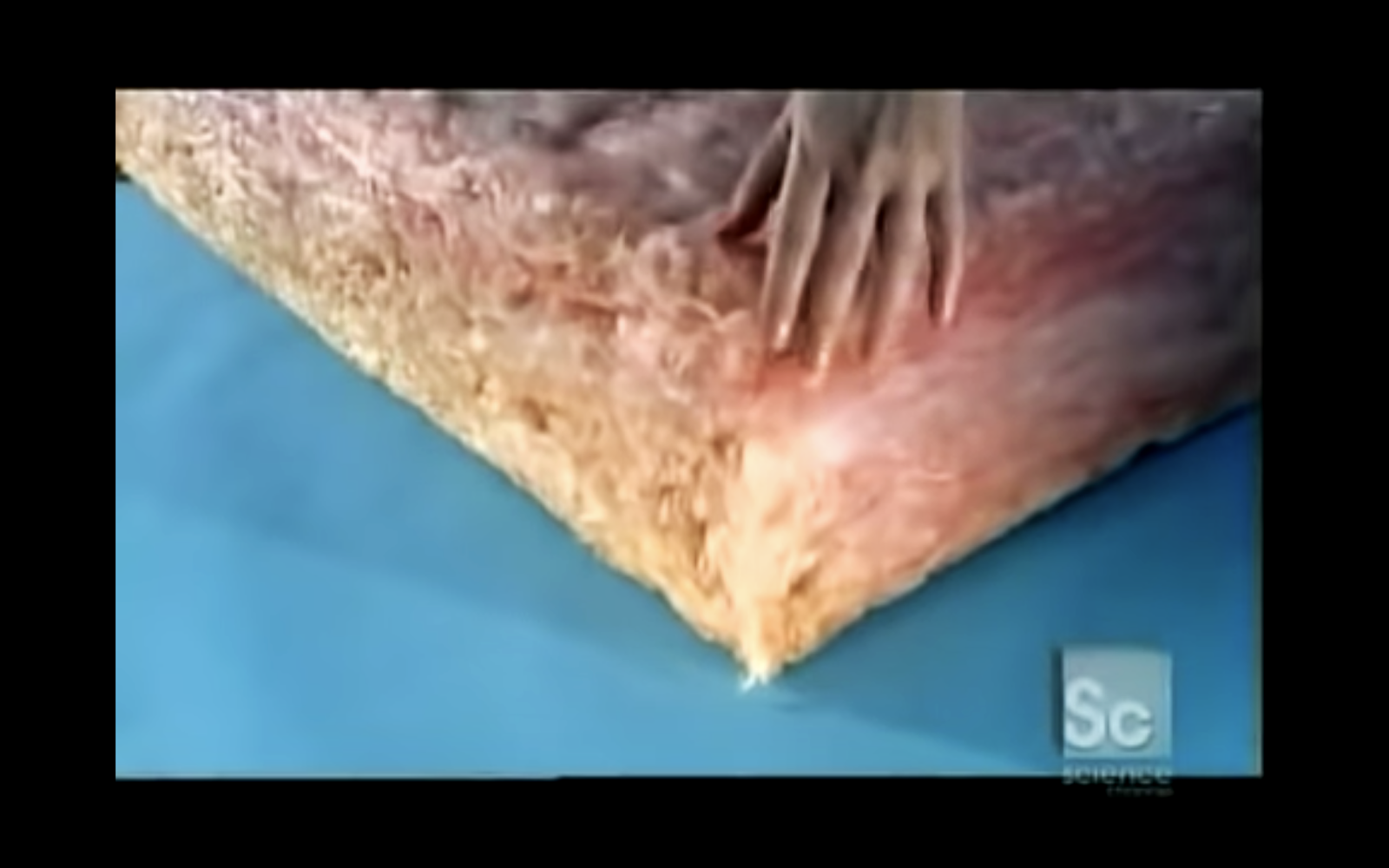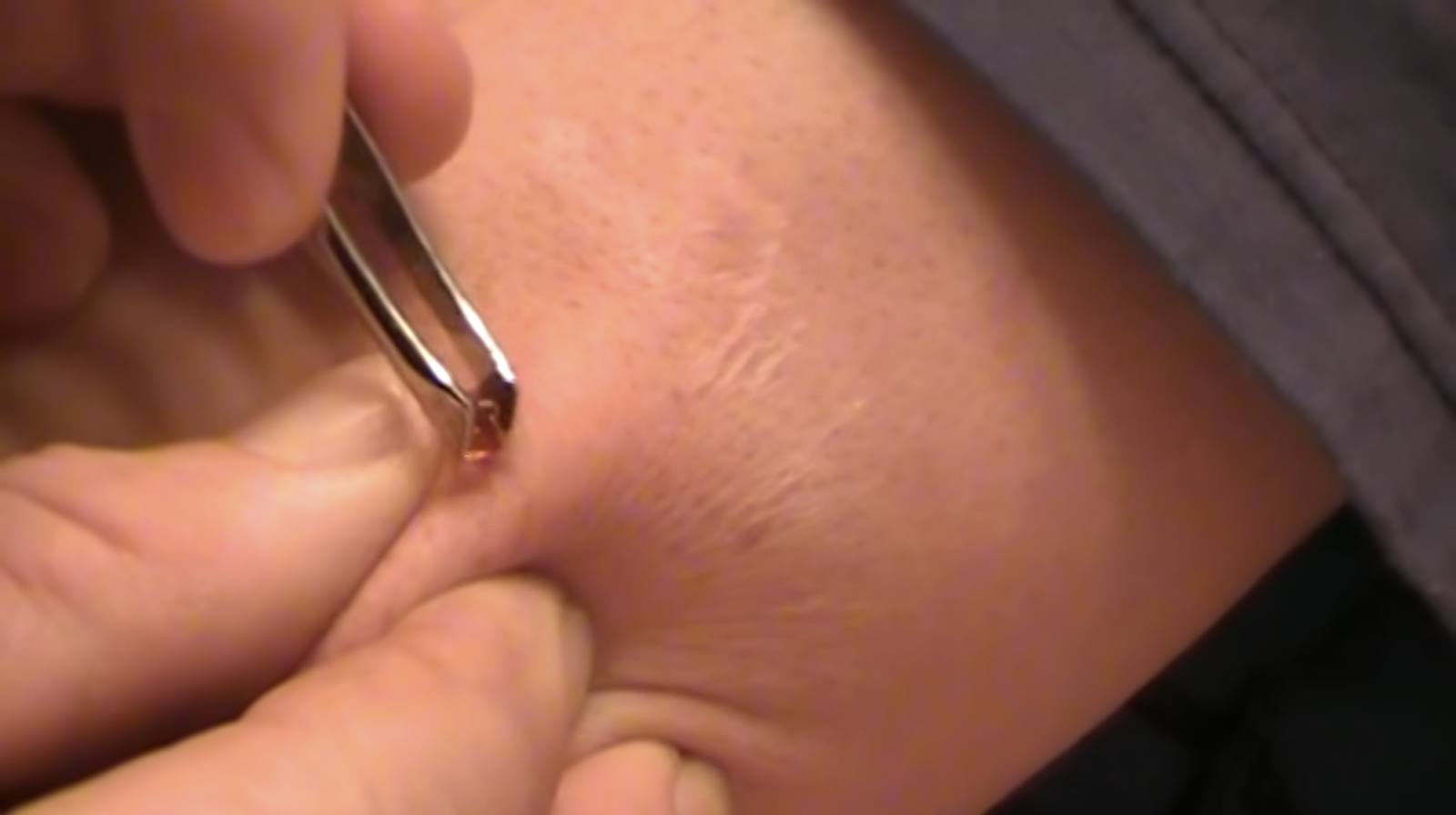A Record of My Porous Body
Contributor
Fashion

Still from “How It’s Made, Fiberglass Insulation.,” youtube.com.
c. 1998, neighbor’s attic, Marblehead, MA
Growing up I’d sneak a peek of it in a neighbor’s unfinished attic amid games of hide-n-seek, or in the outlying corners of a basement, a fluffy substance like a slightly crusted slab of cotton candy, slipping from behind the prim off-white walled interiors of my WASP upbringing. I always had the impulse to roll in it, squeeze it, grab it, an impulse that was usually thwarted or redirected by an aura of risk, hammered into me from repeated parental warnings. No parent wanted to deal with the supreme struggle of extracting countless fine threads of glass out of a squirming kid’s arm. It was a dangerous love object, hidden away in the inaccessible cavities of our homes, interred in sheetrock crypts.
Even if I could stop myself from touching the pink fluff, even when such effusive materials are sealed away in our walls and roofs, human bodies are not insulated from the drift of architectural matter into flesh. We are actually, in a constitutive sense, porous. I recently found myself taking a dive into a Youtube morass of detritus removal videos, the intimate amateur documentation of bodies coping with bumping into “the material residue” of the technosphere.1 This little meeting of synthetic shrapnel and human flesh offers a record of the cyclical replenishment of skin and its asynchronous relation to the eternal persistence of human-fabricated matter. Our bodies are resurfaced every 27 days; glass decomposes in the sigh of a million years.

Still from “Removing 14 year old Glass from my Elbow,” youtube.com.
April 12, 2014, Youtube, worldwide
As a man shows off a glass shard breaching the top layers of his upper left arm after fourteen years of hibernation, the camera pushes in super close, nearly beyond its range of autofocus, simulating the intrigue of over thirty million viewers, to show a purply tender lump. His hands prod and churn the skin into bulging folds, flirting suspensefully with extraction, finally rupturing the last remaining dermal film, letting loose a cyber-enabled shared rush of gratification through removal, the long-awaited divorce from the thing. It’s tempting to explain such a surge of fulfillment as the rectification of some original bodily integrity defiled by the invasion of foreign shards. Yet that would overlook how this is produced by the body’s originary openness to such invasions and defacements, such that a natural and virginal body is always preceded by radical acts of crisscrossing. I feel some irresistible satisfaction as a viewer because of the longue durée of the particulate’s stay within the underlayers of the skin, its stuckness. Inverted, the extraction videos become unnerving celebrations of our bodies’ talents for holding and, eventually, rejecting agents of alterity. They are micro-dramas of bodily autonomy and its undoing, reminders of our conjoinment with the technosphere through repeated, minor, and incomplete acts of separation.
The vast, anonymous, and public broadcasting of baring/emptying reveals a temporal dimension of our inhabitation of the technosphere that passes beyond easy recognition or systemic monitoring. Youtube comments provide ample testimony of lingering pain and odd sensations, inconclusive doctor’s visits, and ad-hoc domestic surgeries. Frequently these work their way into circuits of remote sharing, the world of message boards, gossip, and anecdotes, passing outside of the established medical community responsible for maintaining our bodily vitality. This brings to mind the prevailing—deafening—absence of research on the environmental-industrial causes of cancer—and how this carves a negative space in which the toxicity of the technosphere reigns supreme, in obscurity. The videos give release to a shared poetics of our sociotechnical everyday world, in excess of material function. The play between intrigue and revulsion they illicit is an affectual experience of the dueling attachments to extractive industries and efforts to break or reorder them.

Still from “Disturbing Discovery Of Microplastics Inside Our Bodies,” youtube.com.
August 17, 2020, American Chemical Society, Washington, D.C.
Now these diaries of the technosphere have a fading allure, eclipsed by other, finer material drifts. In 2020 reports began to emerge from the scientific community detailing evidence of a global plastic ambient: human tissue samples laced with plastic monomers, shit dotted with microbeads.2 This evidence passes beyond the limits of macroscopic vision, and thus elides easy detection, recording, sharing, and viewing. The narrative arc of catch, harbor, and release no longer seems to apply, as the body cannot so easily purify itself through public displays of extraction. What new ad-hoc rituals will emerge from the appraisal of microplastics as the inescapable interpenetration of body and other?
March 22, 2021, Cambridge, MA
I have a small purple lump forming on the outside of my right calf. It may turn into a Youtube video.
- Jan Zalasiewicz, “Scale and Diversity of the Physical Technosphere: A Geological Perspective,” The Anthropocene Review 4, no. 1 (2017): 11. Zalasiewicz et al. coin and elaborate the technosphere as “the summed material output of the contemporary human enterprise.” ↩︎
- “Methods for microplastics, nanoplastics and plastic monomer detection and reporting in human tissues,” the American Chemical Society, August 17, 2020. https://www.acs.org/content/acs/en/pressroom/newsreleases/2020/august/micro-and-nanoplastics-detectable-in-human-tissues.html. ↩︎